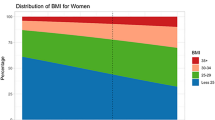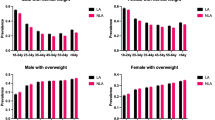Abstract
Background:
Obesity interventions are implemented at state or sub-state level in the United States (US), where only self-reported weight and height data for adults are available from the Behavioral Risk Factor Surveillance System (BRFSS). The prevalence estimates of overweight and obesity generated from self-reported weight and height from BRFSS are known to underestimate the true prevalence. However, whether this underestimation is consistent across different demographic groups has not been fully investigated.
Methods:
In this study, we compared the prevalence estimates of obesity (body mass index (BMI) ⩾30 kg/m2) and overweight (BMI ⩾25 kg/m2) in different demographic groups in the US from the National Health and Nutrition Examination Survey (NHANES) and BRFSS during 1999–2000. We also compared the rank orders of the obesity and overweight prevalence across different demographic groups from the two data sources.
Results:
Compared to NHANES, BRFSS underestimated the overall prevalence of obesity and overweight by 9.5 and 5.7 percentage points, respectively. The underestimation differed across different demographic groups: the underestimation of obesity and overweight prevalence was higher among women (13.1 and 12.2 percentage points, respectively) than among men (5.8 and −0.6 percentage points, respectively). The variation of underestimation was higher among men. A clear inverse association between educational attainment and obesity prevalence among non-Hispanic African American women was observed from BRFSS data. However, no such association was found from NHANES. While BRFSS can identify correctly the population with the highest obesity and overweight burden, it did not accurately rank the obesity and overweight prevalence across different demographic groups.
Conclusion:
Compared to NHANES, BRFSS disproportionately underestimates the prevalence of obesity and overweight across different gender, race, age, and education subgroups.
This is a preview of subscription content, access via your institution
Access options
Subscribe to this journal
Receive 12 print issues and online access
$259.00 per year
only $21.58 per issue
Buy this article
- Purchase on Springer Link
- Instant access to full article PDF
Prices may be subject to local taxes which are calculated during checkout
Similar content being viewed by others
References
Flegal KM, Carrol MD, Ogden CL, Johnson CL . Prevalence and trends in obesity among US adults, 1999–2000. JAMA 2002; 288: 1723–1727.
Scaglione R, Argano C, Di Chiara T, Licata G . Obesity and cardiovascular risk: the new public health problem of worldwide proportions. Expert Rev Cardiovasc Ther 2004; 2: 203–212.
Reilly JJ, Methven E, McDowell ZC, Hacking B, Alexander D, Stewart L et al. Health consequences of obesity. Arch Dis Child 2003; 88: 748–752.
Finkelstein EA, Fiebelkorn IC, Wang G . National medical spending attributable to overweight and obesity: how much, and who's paying? Health Aff (Millwood) 2003; Suppl): W2219–W2226.
Jackson C, Hatulis DE, Fortmann SP . The Behavior Risk Factor Survey and the Standard Five-City Project Survey: a comparison of cardiovascular risk behavior estimates. Am J Public Health 1992; 82: 412–416.
Paccaud F, Wietlisbach V, Rickenbach M . Body mass index: comparing mean values and prevalence rates from telephone and examination surveys. Rev Epidemiol Sante Publ 2001; 49: 33–40.
Bowlin SJ, Morrill BD, Nafziger AN, Jenkins PL, Lewis C, Pearson TA . Validity of cardiovascular disease risk factors assessed by telephone survey: the Behavior Risk Factor Survey. J Clin Epidemiol 1993; 46: 561–571.
Centers for Disease Control and Prevention. National Health and Nutrition Examination Survey. Available at: http://www.cdc.gov/nchs/nhanes.htm.
Centers for Disease Control and Prevention. Behavior Risk Factor Surveillance System. Available at: http://www.cdc.gov/brfss.
Casella G, Berger RL . Statistical Inference 1st edn. Duxbury Press: California, 1990.
US Census Bureau and United State Census. 2000. Available at: http://www.census.gov/main/www/cen2000.html.
Kuczmarski MF, Kuczmarski RJ, Najjar M . Effects of age on validity of self-reported height, weight, and body mass index: findings from the third national health and nutrition examination survey, 1998–1994. J Am Diet Assoc 2001; 10: 28–34.
Nelson DE, Powell-Griner E, Machell T, Kovar MG . A comparison of national estimates from the National Health Interview Survey and the Behavior Risk Factor Surveillance System. Am J Public Health 2003; 93: 1335–1341.
Centers for Disease Control and Prevention. Nutrition and Physical Activity. Available at: http://www.cdc.gov/nccdphp/dnpa/obesity/trend/prev_reg.htm.
Centers for Disease Control and Prevention. Technical Information and Data. Behavior Risk Factor Surveillance System. Available at: http://www.cdc.gov/brfss/technical_infodata/2000QualityReport.htm.
Rowland ML . Self-reported weight and height. Am J Clin Nutr 1990; 52: 1125–1133.
Plankey MW, Stevens J, Flegal KM et al. Prediction equations do not eliminate systematic error in self-reported body mass index. Obes Res 1997; 5: 308–314.
Mensa GA, Mokdad AH, Ford ES et al. State of disparities in cardiovascular health in the United States. Circulation 2005; 111: 1233–1241.
Rocky Mountain Poll. 25 Percent may Drop Hard Wire Phone Service and Rely on their Cell Phones. Available at: http://www.brcpolls.com/02/RMP2002-I-17.PDF.
Acknowledgements
This document was supported by Grant/Cooperative Agreement Number U58/CCU722795-02 from the Centers for Disease Control and Prevention. Its contents are solely our responsibility and do not necessarily represent the official views of the Centers for Disease Control and Prevention.
Author information
Authors and Affiliations
Corresponding author
Rights and permissions
About this article
Cite this article
Yun, S., Zhu, BP., Black, W. et al. A comparison of national estimates of obesity prevalence from the behavioral risk factor surveillance system and the national health and nutrition examination survey. Int J Obes 30, 164–170 (2006). https://doi.org/10.1038/sj.ijo.0803125
Received:
Revised:
Accepted:
Published:
Issue Date:
DOI: https://doi.org/10.1038/sj.ijo.0803125
Keywords
This article is cited by
-
National weighting of data from the Behavioral Risk Factor Surveillance System (BRFSS)
BMC Medical Research Methodology (2016)
-
Maternal pre-pregnancy obesity and childhood physical and cognitive development of children: a systematic review
International Journal of Obesity (2016)
-
The obesity epidemic in the USA — no end in sight?
Nature Reviews Endocrinology (2016)
-
Is obesity related to deteriorating mental health of the U.S. working-age population?
Journal of Behavioral Medicine (2015)
-
A Moving Paradox: A Binational View of Obesity and Residential Mobility
Journal of Immigrant and Minority Health (2015)



